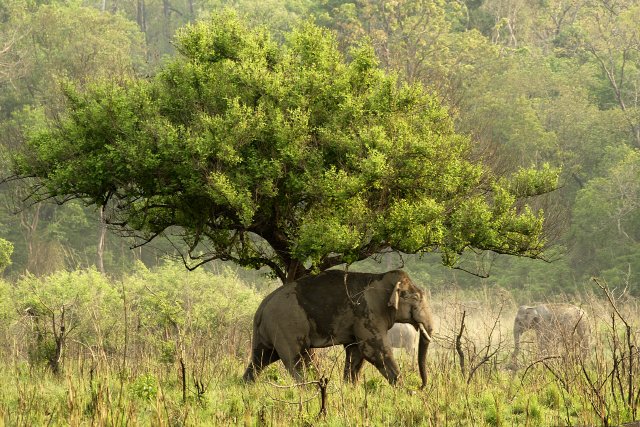They are giants with brains. They are powerful, yet calm. They are the huge Asiatic Elephants.
One of the largest living mammals on the earth, the Asiatic Elephants are among the most sparkling gems of the wildlife treasure trove. Now, blame it on their enormous size, their long tusks, or their calm eyes, but there are numerous reasons to fall for these big mammals. Being a wildlife enthusiast, I have no hesitation in admitting that these giants of the woods have made me their big time buff, and thus, I love to pen down about them.
A Portrait of an Elephant
These large, herbivorous mammals weight between 2.25 to 5.5 tons (2,041 to 4,990 kg) and their height ranges between 6.5 and 11.5 ft (2 to 3 m). Generally gray in color, the two main characteristics of an elephant are their trunks and tusks.
Trunk: A Combination of Upper Lip and an Elongated Nose
With around 60,000 muscles, the trunk is a multipurpose, prehensile organ of elephants. From breathing to touching, from feeding to dusting, from defense to offense…basically from anything to everything that an elephant does is done with the help of its trunk. The trunk can hold approximately four liters of water (I cannot even hold half that amount…I can’t even imagine it)!
Tusk: There Is More to it Than Meets the Eye
Embedded deep in the head, the visible tusk is just two-thirds of the actual tusk. The hidden part is actually a pulp cavity, made of nerves, tissues and blood. The visible part is the ivory portion of the tusk, which contains dentine and is covered with a layer of enamel. The ivory has a criss-cross pattern over it, which creates a series of diamond shapes. Similar to the trunk, the tusk is also used for various purposes. The giant mammals use it to fight their predators like the big cats, and also while combating with other elephants. They also use it for digging, stripping bark, and moving things out of their way. Another important task their tusk performs is that it attracts the females. So, the bigger and stronger the tusk, the more it entices the female elephants.
The Mythology of Elephants
There are basically four species within the family of Asiatic Elephants:
1. Borneo Pygmy Elephants
2. Sri Lankan Elephants
3. Sumatran Elephants
4. Indian Elephants
Being a wildlife enthusiast based in India, I’m slightly more inclined towards the Indian Elephants (perhaps, my inclination is justified). Thus, herein I wish to share a few mythologies related to the Indian Elephants.
So the tale goes that the Gods and the Demons churned the sea to earn nectar concealed deep in the bottom. During this churning, nine jewels came out, and the elephant was one of them. Another legend says that the Indian Elephant is actually the vāhana, or mount of Indra (the king of heaven), and it’s called Airavata. However, being the mount of the deity, this elephant is believed to be bigger than the usual elephants, and has ten tusks! Quite a lot of tusks!
Furthermore, as per the Hindu beliefs, there is an elephant-headed God, Lord Ganesha. It is deemed that the deity can remove all the obstacles from your life. Thus, before beginning any new task, the Hindus pay homage to Lord Ganesha.
The Irony about the Ivory
If Airavat would have been on earth, it would have lost all of its ten tusks. Sad, but true: The tusk that serves various purposes for an elephant is its biggest enemy. This compels me to wonder if ivory is a boon or bane for elephants.
I am sure that this one question has disturbed all wildlife lovers, as the amount of elephant poaching just for the sake of ivory is rising at an alarming rate. There have been incidences wherein elephants are found dead and the tusks are found missing. The reckless poachers are not concerned with the life of the mammal; they are just concerned about the golden coins that the ivory can bring into their pockets. Every year, in every part of Asia where the Asiatic elephants are dwelling, the illegal trade of ivory has seen an rising trend. In the name of medicine, art, and jewelry, the innocent elephants are poached, and the irony is that the one who poaches calls its prey a wild animal.
It is the illegal trade of ivory which has dragged the Asiatic elephants into the zone of being an endangered species. However, the tusk poachers alone can’t be blamed for this because there are a lot of other threats that these huge mammals suffer from:
Habitat Loss
In the process of building our own homes, we are breaching into the boundaries of the wild beings. We say that we are doing all this for the human race—for the brighter future of men—but have we ever pondered on the fact that without the wild beings, there is no future! The elephants play an important role in the ecology and if they disappear, then even the human race will suffer.
Capturing and Dominating
This is also a part of illegal trade, wherein the elephants are captured and sold for various reasons. Some sell the elephants to the circus owners so that they could be used for entertainment, while other elephants are sold for domestic purposes, like carrying loads or helping the so-called superior human race in cutting down woods.
What has been done to save the Asiatic elephants?
Various measures have been taken to save the Asiatic elephants. One of these measures is Project Elephant in India, an initiative by the Government of India Ministry of Environment and Forest for ensuring long term survival of the endangered species. Further, the introduction of unmanned aircrafts in different abodes of elephants in Nepal is another initiative taken for the conservation of the Asiatic elephants. Moreover, illegal trade, which is the foremost threat to the elephants, is handled via stringent rules and regulations. Recently I visited the Chandaka Elephant Reserve in Bhubneshwar, India, and I was glad to see stringent patrolling there.
How can we help?
You must have heard the phrase charity begins from home. Thus, if we really wish to save the elephants, first we will have to change our attitude towards them. Like humans, they also have the right to live and prosper. Their life is as valuable as ours. The more we spread this notion, the more we can lend a hand in conserving these beautiful giant mammals.
Love elephant and want to go steady?
Sign up for our (curated) daily and weekly newsletters!
Editor: Jenna Penielle Lyons
Photo: Wikimedia Commons user Grassjewel (top) and elephant archives (smaller)








Read 0 comments and reply